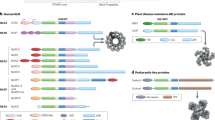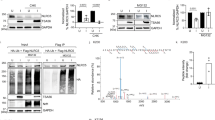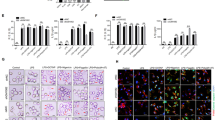Abstract
NOD-like receptors (NLRs) are a family of intracellular proteins that play critical roles in innate immunity against microbial infection. NLRC5, the largest member of the NLR family, has recently attracted much attention. However, in vitro studies have reported inconsistent results about the roles of NLRC5 in host defense and in regulating immune signaling pathways. The in vivo function of NLRC5 remains unknown. Here, we report that NLRC5 is a critical regulator of host defense against intracellular pathogens in vivo. NLRC5 was specifically required for the expression of genes involved in MHC class I antigen presentation. NLRC5-deficient mice showed a profound defect in the expression of MHC class I genes and a concomitant failure to activate L. monocytogenes-specific CD8+ T cell responses, including activation, proliferation and cytotoxicity, and the mutant mice were more susceptible to the pathogen infection. NLRP3-mediated inflammasome activation was also partially impaired in NLRC5-deficient mice. However, NLRC5 was dispensable for pathogen-induced expression of NF-κB-dependent pro-inflammatory genes as well as type I interferon genes. Thus, NLRC5 critically regulates MHC class I antigen presentation to control intracellular pathogen infection.
Similar content being viewed by others
Log in or create a free account to read this content
Gain free access to this article, as well as selected content from this journal and more on nature.com
or
References
Schroder K, Tschopp J . The inflammasomes. Cell 2010; 140:821–832.
Elinav E, Strowig T, Henao-Mejia J, Flavell RA . Regulation of the antimicrobial response by NLR proteins. Immunity 2011; 34:665–679.
Kanneganti TD . Central roles of NLRs and inflammasomes in viral infection. Nat Rev Immunol 2010; 10:688–698.
Kanneganti TD, Lamkanfi M, Núñez G . Intracellular NOD-like receptors in host defense and disease. Immunity 2007; 27:549–559.
Davis BK, Wen H, Ting JP . The inflammasome NLRs in immunity, inflammation, and associated diseases. Annu Rev Immunol 2011; 29:707–735.
Sorbara MT, Girardin SE . Mitochondrial ROS fuel the inflammasome. Cell Res 2011; 21:558–560.
Lamkanfi M, Kanneganti TD . Regulation of immune pathways by the NOD-like receptor NLRC5. Immunobiology 2011; 217:13–16.
Magalhaes JG, Sorbara MT, Girardin SE, Philpott DJ . What is new with Nods? Curr Opin Immunol 2010; 23:29–34.
Meissner TB, Li A, Kobayashi KS . NLRC5: a newly discovered MHC class I transactivator (CITA). Microbes Infect 2011 Dec 22. doi:10.1016/j.micinf.2011.12.007
Neerincx A, Lautz K, Menning M, et al. A role for the human nucleotide-binding domain, leucine-rich repeat-containing family member NLRC5 in antiviral responses. J Biol Chem 2010; 285:26223–26232.
Meissner TB, Li A, Biswas A, et al. NLR family member NLRC5 is a transcriptional regulator of MHC class I genes. Proc Natl Acad Sci USA 2010; 107:13794–13799.
Cui J, Zhu L, Xia X, et al. NLRC5 negatively regulates the NF-kappaB and type I interferon signaling pathways. Cell 2010; 141:483–496.
Benko S, Magalhaes JG, Philpott DJ, Girardin SE . NLRC5 limits the activation of inflammatory pathways. J Immunol 2010; 185:1681–1691.
Kuenzel S, Till A, Winkler M, et al. The nucleotide-binding oligomerization domain-like receptor NLRC5 is involved in IFN-dependent antiviral immune responses. J Immunol 2010; 184:1990–2000.
Meissner TB, Li A, Liu YJ, Gagnon E, Kobayashi KS . The nucleotide-binding domain of NLRC5 is critical for nuclear import and transactivation activity. Biochem Biophys Res Commun 2012; 418:786–791.
Davis BK, Roberts RA, Huang MT, et al. Cutting edge: NLRC5-dependent activation of the inflammasome. J Immunol 2010; 186:1333–1337.
Kumar H, Pandey S, Zou J, et al. NLRC5 deficiency does not influence cytokine induction by virus and bacteria infections. J Immunol 2010; 186:994–1000.
Zijlstra M, Bix M, Simister NE, et al. Beta 2-microglobulin deficient mice lack CD4-8+ cytolytic T cells. Nature 1990; 344:742–746.
Neefjes J, Jongsma ML, Paul P, Bakke O . Towards a systems understanding of MHC class I and MHC class II antigen presentation. Nat Rev Immunol 2011; 11:823–836.
Martinon F, Petrilli V, Mayor A, Tardivel A, Tschopp J . Gout-associated uric acid crystals activate the NALP3 inflammasome. Nature 2006; 440:237–241.
Meixenberger K, Pache F, Eitel J, et al. Listeria monocytogenes-infected human peripheral blood mononuclear cells produce IL-1beta, depending on listeriolysin O and NLRP3. J Immunol 2009; 184:922–930.
Zika E, Ting JP . Epigenetic control of MHC-II: interplay between CIITA and histone-modifying enzymes. Curr Opin Immunol 2005; 17:58–64.
Chang CH, Guerder S, Hong SC, van Ewijk W, Flavell RA . Mice lacking the MHC class II transactivator (CIITA) show tissue-specific impairment of MHC class II expression. Immunity 1996; 4:167–178.
Masternak K, Muhlethaler-Mottet A, Villard J, et al. CIITA is a transcriptional coactivator that is recruited to MHC class II promoters by multiple synergistic interactions with an enhanceosome complex. Genes Dev 2000; 14:1156–1166.
Inaba K, Inaba M, Romani N, et al. Generation of large numbers of dendritic cells from mouse bone marrow cultures supplemented with granulocyte/macrophage colony-stimulating factor. J Exp Med 1992; 176:1693–1702.
Zhu S, Pan W, Shi P, et al. Modulation of experimental autoimmune encephalomyelitis through TRAF3-mediated suppression of interleukin 17 receptor signaling. J Exp Med 2010; 207:2647–2662.
Hayashi T, Hideshima T, Akiyama M, et al. Ex vivo induction of multiple myeloma-specific cytotoxic T lymphocytes. Blood 2003; 102:1435–1442.
Xu H, Chun T, Choi HJ, Wang B, Wang CR . Impaired response to Listeria in H2-M3-deficient mice reveals a nonredundant role of MHC class Ib-specific T cells in host defense. J Exp Med 2006; 203:449–459.
Acknowledgements
This work was supported by grants from the National Natural Science Foundation of China (30930084, 91029708 and 30871298), the National Basic Research Program of China (973 program; 2010CB529705), the Chinese Academy of Sciences (KSCX2-YW-R-146) and the Science and Technology Commission of Shanghai Municipality (10JC1416600). It was also supported by the Shanghai Hospital Science & Technology Resource Sharing Program funded by Shanghai Shenkang Hospital Development Center (SHDC12007708).
Author information
Authors and Affiliations
Corresponding author
Additional information
( Supplementary information is linked to the online version of the paper on the Cell Research website.)
Supplementary information
Supplementary information, Figure S1
The targeting strategy and genotyping of Nlrc5−/− mice. (PDF 73 kb)
Supplementary information, Figure S2
NLRC5 regulates MHC class I gene expression. (PDF 138 kb)
Supplementary information, Figure S3
NLRC5 regulates CD8+ but not CD4+ T cell activation. (PDF 122 kb)
Supplementary information, Figure S4
TCR activation-induced signaling and IFNγ production is normal in Nlrc5-deficient CD8+ T cells. (PDF 81 kb)
Supplementary information, Figure S5
NLRC5 promotes NLRP3 inflammasome activation. (PDF 124 kb)
Supplementary information, Figure S6
NLRC5 does not affect LPS-, poly(I:C)- or poly(dA:dT)-induced expression of NF-κB-dependent genes. (PDF 140 kb)
Rights and permissions
About this article
Cite this article
Yao, Y., Wang, Y., Chen, F. et al. NLRC5 regulates MHC class I antigen presentation in host defense against intracellular pathogens. Cell Res 22, 836–847 (2012). https://doi.org/10.1038/cr.2012.56
Received:
Revised:
Accepted:
Published:
Issue date:
DOI: https://doi.org/10.1038/cr.2012.56
Keywords
This article is cited by
-
NLRC5/CITA expression correlates with efficient response to checkpoint blockade immunotherapy
Scientific Reports (2021)
-
NLRC5 regulates expression of MHC-I and provides a target for anti-tumor immunity in transmissible cancers
Journal of Cancer Research and Clinical Oncology (2021)
-
Arid2-IR promotes NF-κB-mediated renal inflammation by targeting NLRC5 transcription
Cellular and Molecular Life Sciences (2021)
-
NLRC5 inhibits neointima formation following vascular injury and directly interacts with PPARγ
Nature Communications (2019)
-
Class I transactivator, NLRC5: a central player in the MHC class I pathway and cancer immune surveillance
Immunogenetics (2019)



